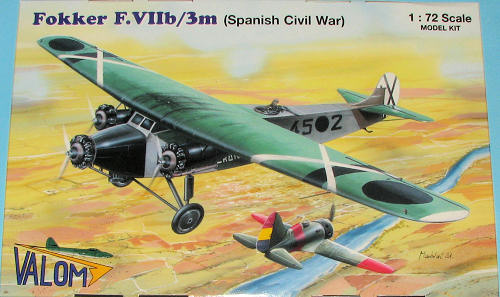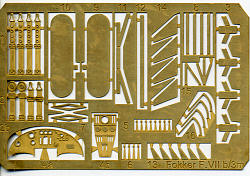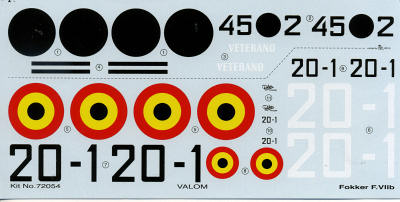
Valom 1/72 Fokker F.VIIb/3m (Spanish Civil War)
| KIT #: | 72054 |
| PRICE: | $ |
| DECALS: | Two Options |
| REVIEWER: | Scott Van Aken |
| NOTES: | Short run with photo etched and resin parts. |

| HISTORY |
Fokker F.VII was an airliner produced in the 1920s by the Dutch aircraft manufacturer Fokker, Fokker's American subsidiary Atlantic Aircraft Corporation, and other companies under license.
The original Walter Rethel design of 1924 was a single-engined high-winged monoplane. Anthony Fokker modified the design with two additional engines to enter the inaugural Ford Reliability Tour in 1925, which it won. Consequently, the production versions F.VIIa/3m, F.VIIb/3m and F.10 all had three engines, and the aircraft became popularly known as the Fokker Trimotor.
The F.VIIa/3m was the intitial version with two additional underwing engines, flown on September 4, 1925. The first two aircraft were identical to the F.VIIa. From the third aircraft, the fuselage was 31 in (80 cm) longer and was powered by with 200 hp (149 kW) Wright J-4 Whirlwind radial engines. Probably only 18 were built while many F.VIIas were upgraded to the F.VIIa/3m standard. The F.VIIIb/3m was the main production version with greater span, 154 built including built under license. The Spanish Air Force had seven of these, which operated on both sides of the conflict during the Spanish Civil War.
| THE KIT |
 This Valom's long awaited (at least by me) kit of the Fokker F.VIIb/3m. It is only natural that they'd pick a boxing that might have less interest than the others and chose the ones used during the Spanish Civil War. From the looks of the sprues, you could easily do other versions as there are a number of parts not used during this build, including engine cowlings.
This Valom's long awaited (at least by me) kit of the Fokker F.VIIb/3m. It is only natural that they'd pick a boxing that might have less interest than the others and chose the ones used during the Spanish Civil War. From the looks of the sprues, you could easily do other versions as there are a number of parts not used during this build, including engine cowlings.
There are two large tan sprues, one clear sprue, a bag of resin and a small etched sprue. Starting with the resin, this is for the engines, wheels, guns and a few other small bits. Photo etch is used for a number of small cockpit details including belts and an instrument panel. There are also a number of p.e. parts for the exterior. The clear sprue includes the windscreen and cabin windows, with an alternate set that is not used. The sprue is well molded.
The two main tan sprues have a number of bits not used including two other sets of props, and the cabin seats, for they are not shown as being used in the instructions. The parts are well molded with crisp engraved panel lines. I found a few bits had sink areas (the cabin seats and outer gear struts), there are ejector towers on the wings and fuselage you'll have to remove, and some of the bits were suffering from mold mismatch, though it was only a few. Some of the parts are quite fragile looking (such as the interior framing) so a razor saw might not be a bad idea. Test fitting some of the larger bits showed that the fit will be quite good once the mating surfaces have been scraped. This is a short run kit and one has to do a few extra steps to ensure proper parts fit.
Instructions are well done with clear construction steps. The paint chart provides a number of different paint lines. This kit has an upper fuselage machine gun position. Yet, neither on the part or in the instructions does it say anything about opening up a hole in the fuselage for it. In one construction step it is not there and in the next one it magically appears. No indication of the size of hole needed. There is nothing in the way of a gunner's seat for this, just the Scarff ring and gun. I would suggest some research into this to see if the kit can be built without it. Or perhaps paint the area in the cent with black paint.
the kit can be built without it. Or perhaps paint the area in the cent with black paint.
 There are markings options for two planes; one for the Nationalist forces in what looks like standard Luftwaffe colors of RLM 62/63/64/65 as shown on the box top. The other is a Republican aircraft with basically an aluminum dope fuselage and green upper wing. The decals are superbly printed and before you wonder if the center of the Republican roundels is black, well it is on the main sheet. Valom realized the goof and a second set of roundels with the dark purple center is in with the kit.
There are markings options for two planes; one for the Nationalist forces in what looks like standard Luftwaffe colors of RLM 62/63/64/65 as shown on the box top. The other is a Republican aircraft with basically an aluminum dope fuselage and green upper wing. The decals are superbly printed and before you wonder if the center of the Republican roundels is black, well it is on the main sheet. Valom realized the goof and a second set of roundels with the dark purple center is in with the kit.
| CONCLUSIONS |
No longer will we have to cobble together something using the old Frog kit. We now have a modern version of the F.VIIb/3m and if you are as pleased as I, then you should seek this one out.
| REFERENCES |
http://en.wikipedia.org/wiki/Fokker_F.VII
April 2010
My thanks to Valom for sending in the preview kit.
If you would like your product reviewed fairly and fairly quickly, please contact the editor or see other details in the
Back to the Previews Index Page